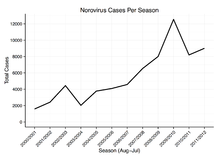Norovirus is a
genus of genetically diverse single-stranded RNA, non-
enveloped viruses in the
Caliciviridae family.
[1] The known viruses in the genus are all considered to be the variant strains of a single species called
Norwalk virus. The viruses are transmitted by
fecally contaminated food or water; by person-to-person contact;
[2] and via
aerosolization of the virus and subsequent contamination of surfaces.
[3] Noroviruses are the most common cause of viral
gastroenteritis in humans, and affect people of all ages.
[4]
Norovirus infection is characterized by nausea, forceful vomiting,
watery diarrhea, and abdominal pain, and in some cases, loss of taste.
General lethargy, weakness, muscle aches, headache, coughs, and
low-grade fever may occur. The disease is usually self-limiting, and
severe illness is rare. The virus affects around 267 million people and
causes over 200,000 deaths each year; these deaths are usually in less
developed countries and in the very young, elderly and
immuno-suppressed.
[5]
Winter vomiting bug is a common term for noroviruses in the
UK, because the virus tends to cause vomiting and to spread more easily
in winter, when people tend to spend more time indoors and near to each
other.
[6]
After
infection,
immunity to norovirus is usually incomplete and temporary
[7]
with one publication drawing the conclusion that protective immunity to
the same strain of norovirus lasts for six months, but that all such
immunity is gone after two years.
[8]
Outbreaks of norovirus infection often occur in closed or semiclosed
communities, such as long-term care facilities, overnight camps,
hospitals, prisons, dormitories, and cruise ships, where the infection
spreads very rapidly either by person-to-person transmission or through
contaminated food.
[9] Many norovirus outbreaks have been traced to food that was handled by one infected person.
[10]
Norovirus is rapidly inactivated by either sufficient heating or by
chlorine-based disinfectants, but the virus is less susceptible to alcohols and detergents, as it does not have a
lipid envelope.
[11]
The genus name
Norovirus is derived from
Norwalk virus, the only species of the genus. The species causes approximately 90% of
epidemic nonbacterial outbreaks of
gastroenteritis around the world,
[12] and may be responsible for 50% of all foodborne outbreaks of gastroenteritis in the United States.
[13][14]
Diagnosis
Specific diagnosis of norovirus is routinely made by
polymerase chain reaction (PCR)
assays or
quantitative PCR assays, which give results within a few hours. These assays are very sensitive and can detect as few as 10 virus particles.
[15]
Tests such as
ELISA that use
antibodies against a mixture of norovirus strains are available commercially, but lack
specificity and
sensitivity.
[16]
Virology
Transmission
Noroviruses are transmitted directly from person to person and
indirectly via contaminated water and food. They are extremely
contagious, and fewer than twenty virus particles can cause an infection
[4] (some research suggests as few as five).
[8] Transmission occurs through ingesting contaminated food and water and by person-to-person spread. Transmission can be
aerosolized
when those stricken with the illness vomit, and can be aerosolized by a
toilet flush when vomit or diarrhea is present; infection can follow
eating food or breathing air near an episode of vomiting, even if
cleaned up.
[17] The viruses continue to be shed after symptoms have subsided and shedding can still be detected many weeks after infection.
[18]
Vomiting, in particular, transmits infection effectively. In one
incident, a person who vomited spread infection right across a
restaurant, suggesting that many unexplained cases of food poisoning may
have their source in vomit. 126 people were dining at six tables in
December 1998; one woman vomited. Staff quickly cleaned up, and people
continued eating. Three days later others started falling ill; 52 people
reported a range of symptoms, from fever and nausea to vomiting and
diarrhea. The cause was not immediately identified. Researchers plotted
the seating arrangement: more than 90% of the people at the same table
as the sick woman later reported becoming ill. There was a direct
correlation between the risk of infection of people at other tables and
how close they were to the sick woman. More than 70% of the diners at an
adjacent table fell ill; at a table on the other side of the
restaurant, the rate was still 25%. The outbreak was attributed to a
Norwalk-like virus (norovirus). Other cases of transmission by vomit
were later identified.
In one outbreak at an international scout jamboree in the
Netherlands, each person with gastroenteritis infected an average of 14
people before increased hygiene measures were put in place. Even after
these new measures were enacted, an ill person still infected an average
of 2.1 other people.
[19] A
CDC study of 11 outbreaks in
New York State lists the suspected
mode of transmission
as person-to-person in seven outbreaks, foodborne in two, waterborne in
one, and one unknown. The source of waterborne outbreaks may include
water from municipal supplies, wells, recreational lakes, swimming pools
and ice machines.
[20]
Shellfish
and salad ingredients are the foods most often implicated in norovirus
outbreaks. Ingestion of shellfish that have not been sufficiently heated
poses a high risk for norovirus infection.
[21] Foods other than shellfish may be contaminated by infected food handlers.
[22]
Classification

Transmission electron micrograph of norovirus particles in feces
Noroviruses (NoV) are a genetically diverse group of single-stranded RNA, non-
enveloped viruses belonging to the
Caliciviridae family.
[23] According to the International Committee on Taxonomy of Viruses, the
genus Norovirus has one species, which is called
Norwalk virus.
[1] Serotypes, strains and isolates include:
[24]
- Norwalk virus;
- Hawaii virus;
- Snow Mountain virus;
- Mexico virus;
- Desert Shield virus;
- Southampton virus;
- Lordsdale virus;
- Wilkinson virus.[25]
Noroviruses commonly isolated in cases of acute gastroenteritis
belong to two genogroups: genogroup I (GI) includes Norwalk virus,
Desert Shield virus and Southampton virus; and II (GII), which includes
Bristol virus, Lordsdale virus, Toronto virus, Mexico virus, Hawaii
virus and Snow Mountain virus.
[23]
Noroviruses can genetically be classified into five different
genogroups (GI, GII, GIII, GIV, and GV), which can be further divided
into different genetic clusters or
genotypes.
For example, genogroup II, the most prevalent human genogroup,
presently contains 19 genotypes. Genogroups I, II and IV infect humans,
whereas genogroup III infects
bovine species, and genogroup V has recently been isolated in mice.
[25]
Most noroviruses that infect humans belong to genogroups GI and GII.
[26] Noroviruses from Genogroup II, genotype 4 (abbreviated as GII.4) account for the majority of adult outbreaks of
gastroenteritis and often sweep across the globe.
[27] Recent examples include US95/96-US strain, associated with global outbreaks in the mid- to late-1990s;
Farmington Hills virus associated with outbreaks in
Europe
and the United States in 2002 and in 2004; and Hunter virus which was
associated with outbreaks in Europe, Japan and Australasia. In 2006,
there was another large increase in NoV infection around the globe.
[28]
Reports have shown a link between the expression of human histo-blood
group antigens (HBGAs) and the susceptibility to norovirus infection.
Studies have suggested the viral capsid of noroviruses may have evolved
from selective pressure of human HBGAs.
[29]
A 2008 study suggests the protein
MDA-5 may be the primary immune sensor that detects the presence of noroviruses in the body.
[30]
Interestingly, some people have common variations of the MDA-5 gene
that could make them more susceptible to norovirus infection.
[31]
A 2010 study suggested a specific genetic version of norovirus (which
would not be distinguishable from other types of the virus using
standard viral antibody tests) interacts with a specific mutation in the
ATG16L1 gene to help trigger symptomatic
Crohn's disease
in mice that have been subjected to a chemical that causes intestinal
injury similar to the process in humans. (There are other similar ways
for such diseases to happen like this, and this study in itself does not
prove norovirus causes Crohn's in humans).
Structure

X-ray crystallographic structure of the Norwalk virus capsid.
Noroviruses contain a
positive-sense RNA genome of approximately 7.5
kbp, encoding a major structural
protein (VP1) of about 58~60
kDa and a minor
capsid protein (VP2).
[32] The virus particles demonstrate an amorphous surface structure when visualized using
electron microscopy and are between 27-38
nm in size.
[33]
The most variable region of the viral capsid is the P2 domain, which
contains antigen-presenting sites and carbohydrate-receptor binding
regions.
[34][35][36][37]
The estimated mutation rate (1.21 x 10
−2 to 1.41 x 10
−2 substitutions per site per year) in this virus is high even compared with other RNA viruses.
[38]
Pathophysiology
When a person becomes infected with norovirus, the virus begins to
replicate within the
small intestine. After approximately one to two days, norovirus infection symptoms can appear. The principal symptom is acute
gastroenteritis that develops between 24 and 48 hours after exposure, and lasts for 24–60 hours.
[14] The disease is usually
self-limiting, and characterized by nausea, forceful vomiting, watery
diarrhea,
and abdominal pain, and in some cases, loss of taste. General lethargy,
weakness, muscle aches, headache, coughs, and low-grade fever may
occur.
Severe illness is rare; although people are frequently treated at the emergency ward, they are rarely admitted to the
hospital.
The number of deaths from norovirus in the United States is estimated
to be around 300 each year, with most of these occurring in the very
young, the elderly, and persons with weakened immune systems. Symptoms
may become life-threatening in these groups if
dehydration is ignored or not treated.
[2]
Prevention
Hand washing with soap and water is an effective method for reducing the transmission of norovirus
pathogens. Alcohol rubs (≥62% ethanol) may be used as an adjunct, but are less effective than hand-washing, as norovirus lacks a
lipid viral envelope.
[11]
Surfaces where norovirus particles may be present can be sanitised with
a solution of 1.5% to 7.5% of household bleach in water, or other
disinfectants effective against norovirus.
[39][40][41]
In health-care environments, the prevention of
nosocomial infections involves routine and
terminal cleaning.
Nonflammable alcohol vapor in CO2 systems
are used in health care environments where medical electronics would be
adversely affected by aerosolized chlorine or other caustic compounds.
[42]
Ligocyte announced in 2007 that it was working on a vaccine and had started phase 1 trials.
[43] The company has since been taken over by Takeda.
[44] As of 2011,
a monovalent nasal vaccine had completed phase I/II trials, while
bivalent intramuscular and nasal vaccines were at earlier stages of
development.
[45]
The two vaccines rely on using a virus-like particle that is made of
the Norovirus capsid proteins in order to mimic the external structure
of the virus. Since there is no RNA in this particle, it is incapable of
reproducing and cannot cause an infection.
[43]
Persistence
The norovirus can survive for long periods outside a human host
depending on the surface and temperature conditions: can stay for weeks
on hard surfaces,
[46] and up to 12 days on contaminated fabrics, and it can survive for months, maybe even years in contaminated still water.
[47] A study done in 2006 found the virus still on several surfaces used for food preparation 7 days after contamination.
[48]
Detection in foods
Routine protocols to detect norovirus (norovirus RNA) in clams and oysters by
reverse transcription polymerase chain reaction are being employed by governmental laboratories such as the FDA in the USA.
[49]
Epidemiology

Annual Trend in Reports of Norovirus Infection in England and Wales (2007-2011). Source: HPA

Laboratory reports of norovirus infections in England and Wales 2000-2012. Source: HPA, NB NB Testing methods changed in 2007
[50]
Epidemiological data from developing countries about the importance
of norovirus in pediatric diarrhea are limited. Recently, in Nicaragua,
it has been observed that norovirus is responsible for 11% of the
diarrhea cases occurring in children less than five years of age at
community level and 15% of the moderate to severe cases requiring
intravenous rehydration.
[51]
In the
Guangdong
province of the People's Republic of China, the Provincial Health
Department said on December 17, 2010, that it had confirmed 429 cases of
norovirus infection in the November 2010 outbreak in
Conghua,
Guangzhou, but no one died from it.
[52]
During a two-year (October 2011–January 2013) surveillance for norovirus infection in
Minnesota
among callers to a complaint-based foodborne illness hotline who
reported diarrhea or vomiting, 241 complainants were tested with 127
(52.7%) positive for norovirus. Norovirus is the leading cause of
foodborne disease in the United States.
[53]
Human genetics
A non-functional
fucosyltransferase FUT2 provides high protection from the most common norovirus GII.4.
[54] Functional FUT2 fucosyltransferase transfers a fucose sugar to the end of the Histo-
blood group
ABO(H) precursor in gastrointestinal cells and saliva glands. The ABH
antigen produced is thought to act as receptors for human norovirus.
Homozygous carriers of any nonsense mutation in the FUT2 gene are called
non-secretors, as no ABH antigen is produced. Approximately 20% of
Caucasians are non-secretors due to the G428A and C571T nonsense
mutations in FUT2 and therefore have strong although not absolute
protection from the norovirus GII.4.
[55] Non-secretors can still produce ABH antigens in erythrocytes, as the precursor is formed by FUT1.
[56] Some norovirus genotypes (GI.3) can infect non-secretors.
[57]
Of individuals who are secretor positive, those with blood type O were more likely to be infected and B less likely.
[58][59][60]
History
The norovirus was originally named the "Norwalk agent" after
Norwalk, Ohio, in the United States, where an outbreak of acute gastroenteritis occurred among children at Bronson
Elementary School in November 1968. In 1972, electron microscopy on stored
human stool samples identified a virus, which was given the name "
Norwalk virus." Numerous outbreaks with similar symptoms have been reported since. The
cloning and
sequencing
of the Norwalk virus genome showed that these viruses have a genomic
organization consistent with viruses belonging to the family
Caliciviridae.
[61] The name was shortened to "
norovirus" after being identified in a number of outbreaks on
cruise ships and receiving attention throughout the United States. The name "norovirus" (
Norovirus for the genus) was approved by the
International Committee on Taxonomy of Viruses (ICTV) in 2002.
[62] In 2011, however, a press release and a newsletter
[63]
were published by ICTV, which strongly encourage the media, national
health authorities and the scientific community to use the virus name
Norwalk virus,
rather than the genus name Norovirus, when referring to outbreaks of
the disease. This was also a public response by ICTV to the request from
an individual in Japan to rename the Norovirus genus because of the
possibility of negative associations for people in Japan and elsewhere
who have the family name "Noro". Before this position of ICTV was made
public, ICTV consulted widely with members of the Caliciviridae Study
Group and carefully discussed the case.
In addition to "Norwalk agent" and "Norwalk virus," the virus
previously has been called "Norwalk-like virus," "small,
round-structured viruses" (SRSVs), and "Snow Mountain virus."
[64] Common names of the illness caused by noroviruses still in use include "winter vomiting disease,"
[65] "winter vomiting bug,"
[66][67] "viral gastroenteritis," and "acute nonbacterial gastroenteritis."
[2]
It also colloquially is known as "stomach flu," but this actually is a
broad name that refers to gastric inflammation caused by a range of
viruses and bacteria.


















